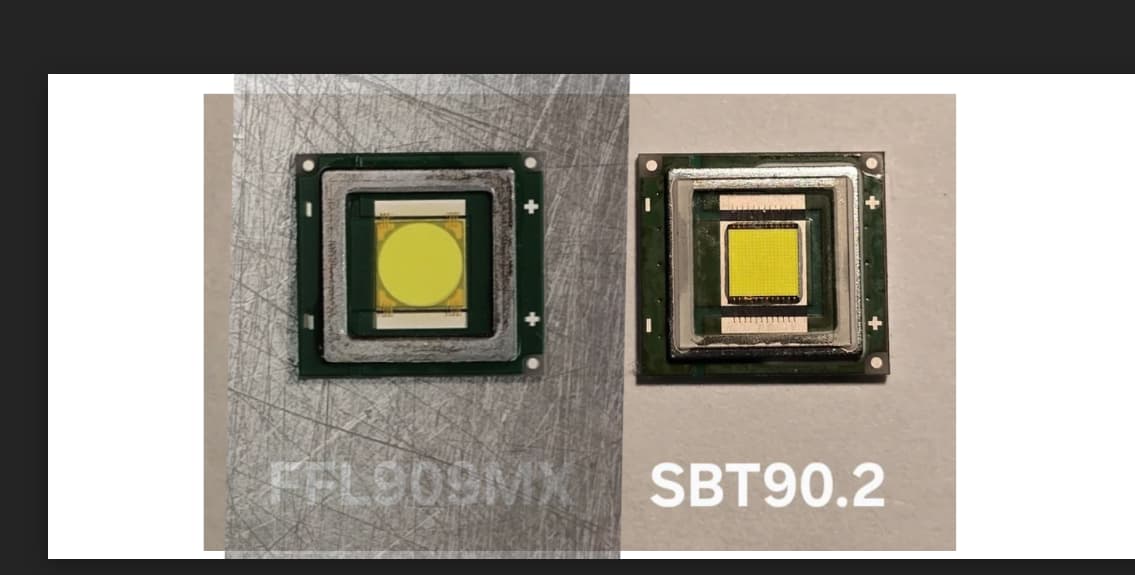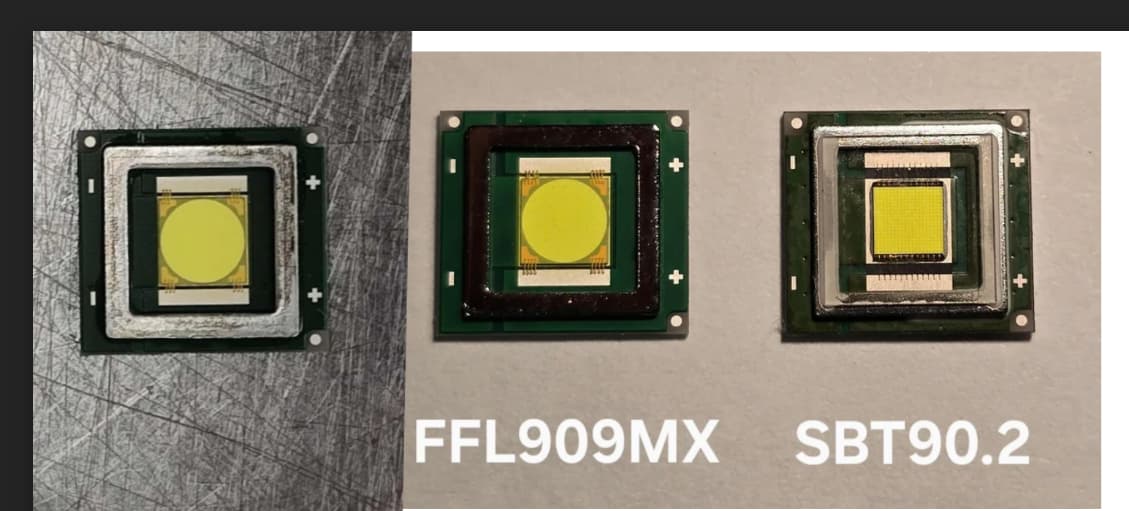2025-04-08
- Type: lateral, monolithic
- Bin: —
- Color group: cool white (5700 K)
- CRI: 70
- Rated voltage: 3 V
- Max. Forward current: 28,000 mA
- Max. Peak current: — mA
- Viewing angle: — °
- Thermal resistance: 0.3 K/W
- Max. Temperature Tj: max. 150°C
Datasheet can be downloaded here: CBT-140-WCS/WDH, 1.7 MB
The CBT-140-W tested here was purchased in used condition on the Chinese second-hand platform Goofish. There is no further information other than the manufacturer and part number. It should be noted that buying from platforms for the Chinese domestic market such as Goofish is not trivial, and forwarding/dropshipping services such as Superbuy do not always work. The results of the test may vary slightly due to existing signs of use.
Since the price of a new CBT-140-W can quickly exceed 130 euros wholesale, a retest with a brand-new sample is not planned.
Visually, the CBT-140 differs significantly from conventional LEDs. The LED chip sits on a 26.75 x 28 mm metal core PCB, which is equipped with flat connectors for connecting cables with cable lugs. A thermistor is located close to the LED chip, directly below the silver-colored frame. A thin AR-coated glass pane is glued to this to protect the sensitive bonding wires.
The LED chip is impressively large with its 14 mm2 circular illuminated area, making it one of the largest monolithic chips ever. LEDs with larger luminous surfaces usually consist of several LED chips arranged in a square or of many small separate chips (in the case of COBs).
The CBT-140 is likely to be so expensive simply because of this huge LED chip, the complex manufacturing process and the associated presumably low yield.
Another unusual feature is the mounting of the large LED chip.
There is no ceramic carrier or EMC, instead the chip is soldered directly onto the MCPCB, which keeps the thermal resistance very low at 0.30 K/W. At the time of release (around 2010-2012), this was an extremely low value, which is only nowadays undercut by large LEDs with a flip chip design such as the XHP70.3, and tends to enable extremely high operating currents. Compared to conventional designs with LED ceramic carriers which are soldered onto an extra MCPCB, this design reduces possible thermal resistance to a minimum. The main limiting factor for thermal conductivity in this case is likely to be the thermal resistance of the sapphire substrate.
The LED chip has a clearly visible dark area at low operating current; it is not clear whether this is due to a fault in the semiconductor or whether this is a problem with the applied phosphor. As the operating current increases, this dark area gradually disappears.
The blue glowing areas at the edges and corners are conspicuous, which is caused by reflected light from the p-n junction in the sapphire substrate.



- at 28,000 mA (official maximum current): 4885 lm @ 3.89 V
- Power at official maximum: 108.8 W
- Efficiency at 2,8000 mA: 44.9 lm/W
- Maximum reached at 53 A, at this point 6206 lm @ 4.43 V
- Power at maximum 235 W
- Efficiency at maximum 26.4 lm/W



Data for 25 °C Tsp (at 85 °C the luminance values are around 13 % lower).
The CBT-140-W has absolutely no chance against today’s LEDs. The efficiency of all modern LEDs is considerably higher. The SBT-90.2 achieves 5000 lm at 19 A, whereas the CBT-140-W still needs 29 A, and this with a significantly smaller illuminated area and a classic ceramic substrate. At the time, however, up to 6000 lumens (!) from a single circular light surface was absolutely impressive, as was the luminance of 194 cd/mm2. However, the Vf seems very high, especially for an LED with a single monolithic chip and the many bonding wires, and the high luminance is only achieved at the cost of an extremely high operating current of max. 53 A and a max. output of 235 W (!!).
The measured flux binning of 4104 lm and 3.70 V at 21 A is in the range of the highest flux bin UB described in the data sheet.
The lower effciency here is probably due to the structural design of the LED chip used, which is probably still as it was in 2010-2012. Although there may have been improvements in production and yield over the production years, making better binnings available, the core characteristics of the semiconductor remain virtually unchanged. For this reason, LED chips have to be redeveloped at some point in order to massively improve the characteristics and characteristics of an LED. Such LEDs are then usually sold as a new product or a new generation, despite the fact that the external design remains partially unchanged.
The beam can be used in reflectors without any problems - as far as this can be tested experimentally. There are no artifacts in either OP or SMO reflectors. However, the design and sheer size of the MCPCB and emitter itself are likely to prevent it from being used in a flashlight.

The CBT-140-WCS is specified with a low color rendering index. The CBT-140-WDH variant, on the other hand, is described as “Daylight white”, with a typical CRI of 92.
For a cool white LED with a low color rendering index, there are few surprises. The CRI is just over 70, but the R9 is in the usual range. A typical YAG:Ce3+ phosphor with emission peak at 545 nm is used. An additional blend for a higher red component is not added. The cyan hole is less pronounced than usual; possibly a small amount of additional blue phosphor is used to increase the bandwidth of the blue region and thus reduce the cyan gap.
The relatively high wavelength of the LED chip at 460 nm is unusual. However, this has also been observed with other Luminus LEDs and could be related to the production of the large LED chip.
The tint is very greenish at low operating currents, but becomes more and more reddish as the operating current increases.
- Ra: 74
- R9: -40
- CCT: 6233 K
- duv: 0.0153
The CBT-140 is still an impressive LED. Not so much because of its performance, which is on a par with that of a few years ago, but because of its design and LED chip. At 14 mm2, it is also absolutely impressive for a single monolithic chip. To date, there is no LED that uses a similarly large single chip.
Due to the special design and the extremely high price, this LED is not suitable for flashlights, not to mention the performance. For flashlights, LEDs such as SBT-90.2/SFT-90 or the well-known multi-die emitters make more sense because of their size, price and efficiency.
Thank you for reading this test. ![]()

